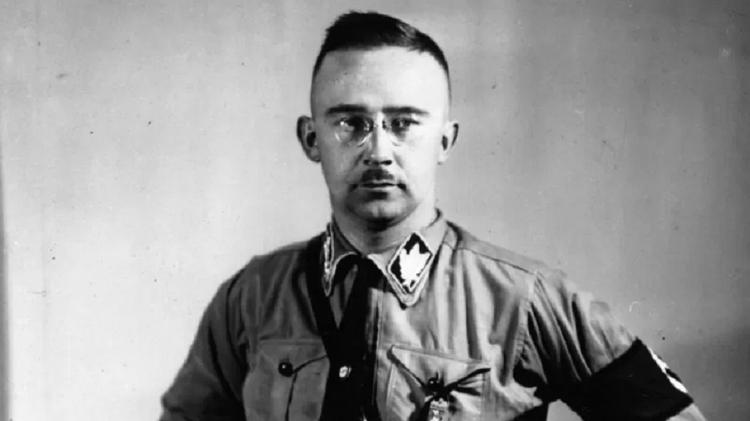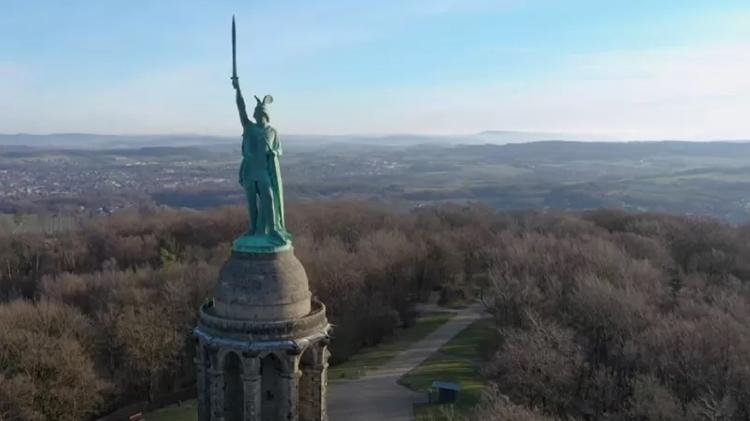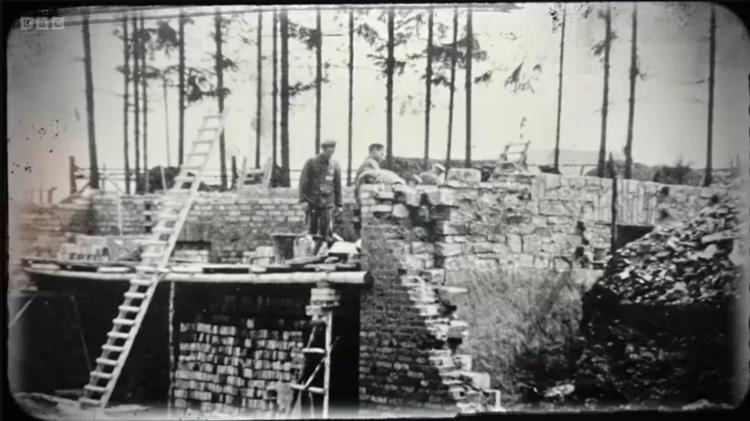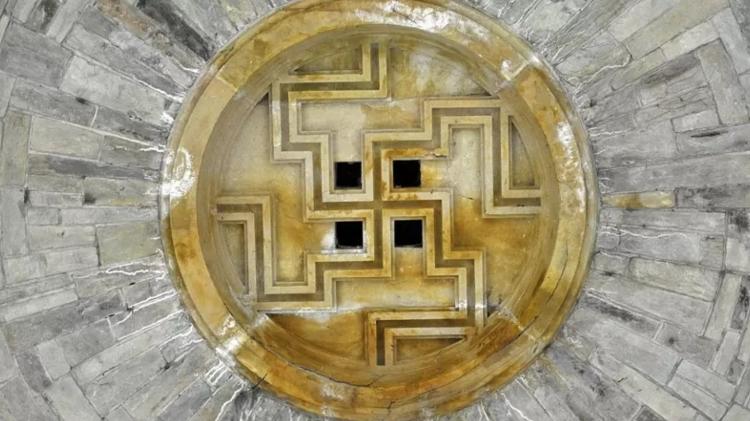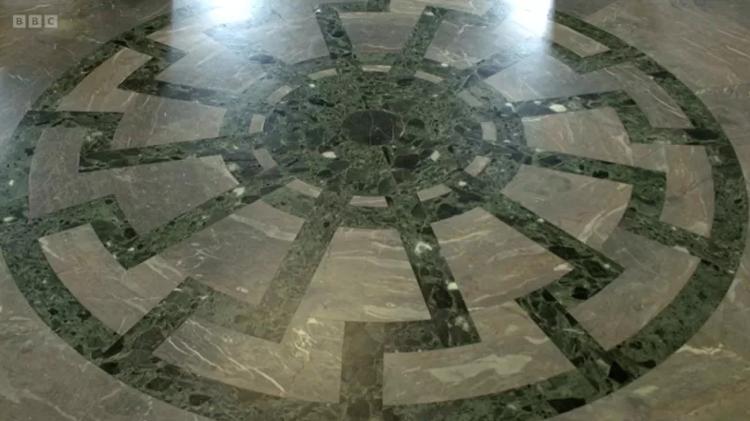Of the nearly 20,000 palaces and castles in Germany, Wewelsburg is the only triangular one. And that’s not the only reason it stands out from the rest.
Perched on a rock overlooking the Alme Valley, the unusual castle was built in the 17th century for the prince-bishops of Paderborn. But it was his tenant in the 1930s that made him even more infamous.
He was none other than Heinrich Himmler, Reichsführer of the SS (Schutzstaffel or Nazi army), meaning he was the supreme leader of the paramilitary, police, political, prison and security organization in Nazi Germany in the service of Adolf Hitler.
Himmler signed a 100-year lease because he “wanted to have a castle where he could meet the highest SS leaders,” Kristen John-Stuke, director of the Kreismuseum Wewelsburg, told BBC Reel.
He wanted to transform it into an important ideological center, to consolidate the elite status of the SS in German society, and to ensure that the organization preserved its purity and common values.
In 1935 it became the “Wewelsburg SS School”.
And after the Second World War, many legends emerged about this place that fed and continue to fuel conspiracy theories.
mysticism
The Nazi Party believed in the supremacy of the so-called Aryan race (or “German blood”).
Many prominent Nazi leaders referred to mythology and legends to support their plans for world domination.
Himmler himself was fascinated by mysticism and the occult, and by linking his interest to their racist philosophies, he offered “evidence” of Aryan and Scandinavian racial superiority since antiquity.
He even envisioned a new pseudo-pagan state religion based on an idealized vision of German chivalric culture and Aryan racial purity.
The SS was to be the ideological precursor to this new faith and a means to instill the Germans in it.
And Wewelsburg Castle would play a central role in the festivities, ceremonies and many ceremonies it created, in which SS officers married and “baptized” their children.
Rumors abound about the castle, but that doesn’t mean they’re true.
german warriors
Himmler did not choose this site for his SS headquarters by chance.
Wewelsbur Castle is located near the Teutoburg Forest, where the Germanic tribes defeated the Roman army 2,000 years ago.
“For Himmler, the Germanic tribes were the highest culture,” said John-Stuke.
“It was very important for him and the SS to have these ties to the past because they could say, ‘We look like Germanic warriors.
The Reichsführer-SS was also obsessed with medieval times, especially the first German king, Henry I, founder of the Saxon dynasty and conqueror of lands in the East, a feat that Nazi Germany wanted to copy.
So, to make Wewelsburg look more medieval, Himmler ordered that all plaster from the walls be removed and a moat built around the castle.
He envisioned it as a new Camelot, complete with a King Arthur-like Round Table around which 12 elected SS officers would sit to serve as his followers.
And he called it “the center of the world”.
And that wasn’t all.
slaves
The rebuilding of Wewesburg was a megalomaniacal plan that, when completed, would transform the castle from the tower into a complex of buildings that would span within a radius of 600 meters.
Due to the large amount of work, Himmler set up his own private concentration camp to use slave labor in the restoration of the castle.
The camp, called Niederhagen, was home to around 4,000 people, about half of whom died as a result of inhumane living conditions and SS abuse.
But setbacks in the war prevented Himmler’s dream from coming true.
In 1943, construction work on Wewelsburg Castle was suspended and the concentration camp was reduced to 42 people.
[In1945Himmler-indefeat-orderedtheforttobedemolishedSStroopstriedtoblowitupfiredestroyedmostofthebuildingandtheremaining42gatheringampprisonerrecoveredbyAmericantroops[1945’teHimmler-yenilgiyle-kaleninyıkılmasınıemrettiveSSbirliklerionuhavayauçurmayaçalıştıYangınbinanınçoğunuyokettivekalan42toplamakampımahkumuAmerikanbirlikleritarafındankurtarıldı
what’s left
“The north tower is still as original as it was in the 1940s,” said John-Stuke.
“There are two historic chambers. One is the vault that looks like a tomb built to honor SS soldiers.”
It has twelve pedestals placed around its circular walls. The shape, acoustics and lighting of the room were designed to create a solemn and mysterious atmosphere. Wells of light illuminate the center of the room where an eternal flame should burn.
Above, on top of the vaulted ceiling of the cellar, is an ornate swastika relief.
At the highest level, there is another controversial symbol associated with the SS ideology of racial superiority.
What once served as the castle’s chapel became the 12-column Hall of the SS Supreme Leaders with church-style semicircular windows and ribbed vaults.
The so-called Black Sun buried in the ground (Schwarze Sonne in German).
Consisting of three circles and twelve “arms” made of badges worn by the SS from 1920 to 1945, it combines three of the most important symbols of Nazi ideology: the sun wheel, the swastika, and the stylized victory rune.
What to do with this legacy?
With this date, Wewelsburg Castle was and always will be a magnet for far-right extremists and esotericists.
But because of its same history, Wewelsburg Castle is considered particularly apt to present not only the crimes of the SS, but also the worldview and historical narrative of the National Socialism criminal organization.
The museum was opened in 1982 to provide a clear view of the horrific activities of the SS and the consequences of their criminal mentality.
“We try to educate people about the history, violence and terror of the SS,” said the site’s administrator.
“It’s very important to us to let visitors enter rooms by themselves. It’s better to show them than hide them.”
To focus on the lessons of what happened and avoid any possible fascination with the ideology of evil, the museum used a special design and a clear presentation of the facts.
deconstruction
For example, in the cellar, the once solemn and mythical atmosphere has been replaced by the inclusion of expressionist motifs that represent the horrors of war.
And in that Hall of Supreme Leaders, colorful poufs distract attention from the inlaid mosaic in the center of the floor. Buried in poufs, visitors adopt different stances and experience new perspectives.
“It’s important for us to show the ‘black sun’, to say ‘Yes, it’s here,’ but we want to disrupt the aura of this symbol.”
“The sun wheel is a typical Indo-Germanic symbol used by many cultures and tribes.”
Also, “we want to show as many original objects as possible, and it’s very complex, perhaps dangerous.”
For this reason, SS items are displayed with information boards that block full view so as not to make room for the sect.
“For example, on a uniform, you can see a swastika on the sleeve, but you can only see part of it. It’s deconstructed.”
“When we show the prisoners the object, everything goes wrong.”
To remove any supposed sense of magic and mystery from Nazi objects, they are contextualized.
For example, a ceramic chandelier as Himmler gave to married SS men at Yule (the holiday that replaces Christmas), as if in a warehouse, and Dachau and Neuengamm.
But the task is not easy.
Complo
“You can’t stop the myths, you can only enlighten people. But it’s hard to work against the conspiracy.”
In the 1990s, a book ignited a new “Black Sun” conspiracy theory and was adopted in esoteric right and far-right political circles as a symbol of liberation and recognition, even replacing the banned swastika.
“This story was very famous. That’s our problem. There are many conspiracy myths and legends about Wewelsberg dating back to the time of the SS.”
“They started as soon as the war was over, when SS members told stories that Himmler was planning to hold secret rituals in the castle.”
“We can’t say whether it’s true or not because there is no written document about it. All we can say for sure is that it was never used because the work was never done.”
The only time the SS leadership met in Wewesburg was in June 1941, when the north tower was still under construction.
*This article is partially based on BBC Reel’s Next Stop Stories video. If you want to see, Click here.
– This text was originally published at https://www.bbc.com/portuguese/internacional-62703314.
Did you know that the BBC is also on Telegram? subscribe to the channel.
source: Noticias
